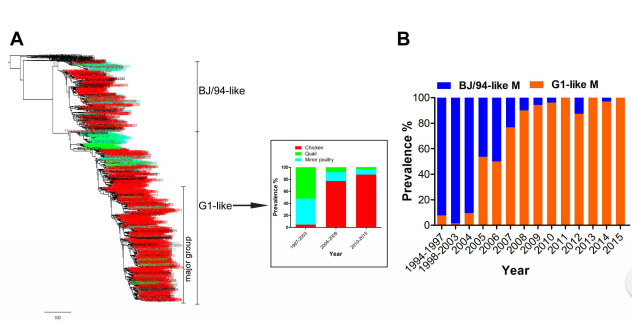Scientists reveal that M gene reassortment in H9N2 influenza virus promotes early infection and replication
Date:05-04-2017 | 【Print】 【close】
Segment reassortment and base mutagenesis of influenza A viruses are the primary routes to the rapid evolution of high fitness virus genotypes.
Scientists from China Agricultural University, University of Nottingham and Wuhan Institute of Virology recently described a predominant G57 genotype of avian H9N2 viruses that caused country-wide outbreaks in chickens in China during 2010-2013 which led to the zoonotic emergence of H7N9 viruses. One of the key features of the G57 genotype is the substitution of the earlier BJ/94-like M gene with the G1-like M gene of quail origin.
They reported on J Virol. the functional significance of the G1-like M gene in H9N2 viruses in conferring increased infection severity and infectivity in primary chicken embryonic fibroblasts and chickens. H9N2 virus housing the G1-like M gene, in place of BJ/94-like M gene, showed early surge in viral mRNA and vRNA transcription that were associated with enhanced viral protein production, and with early elevated release of progeny virus comprising largely spherical rather than filamentous virions. Importantly, H9N2 virus with G1-like M gene conferred extrapulmonary virus spread in chickens. Five highly represented signature amino acid residues (37A, 95K, 224N and 242N in M1 protein, and 21G in M2 protein) encoded by the prevalent G1-like M gene were demonstrated as prime contributors to enhanced infectivity. Therefore, the genetic evolution of M gene in H9N2 virus increases reproductive virus fitness, indicating its contribution to rising virus prevalence in chickens in China.

Link: http://jvi.asm.org/content/early/2017/01/26/JVI.02055-16.long
Contact:
CUI Jie
E-mail: jiecui@wh.iov.cn
Key Laboratory of Special Pathogens and Biosafety, Center for Emerging Infectious Diseases, Wuhan Institute of Virology, Chinese Academy of Sciences, Wuhan, China (http://english.whiov.cas.cn/)